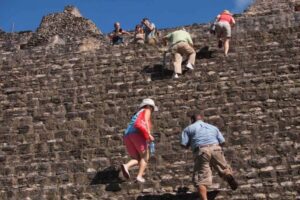On the Trail of the Gauchos in Argentina’s Pampas
By Rosalba O’Brien

In 1866, an English rancher by the name of Wilfred Latham wrote: “I cannot conceive of anything more exhilarating than a gallop across the plains…. a cloudless sky of deep azure, an atmosphere marvelously light and pure communicating a sense of indescribable buoyancy and pleasurable existence – a soft breeze flowing, as it were, over the vast plain, boundless as an ocean – contribute to engender an irresistible feeling of joy.”
Although it sounds like a ride across the American prairie, Latham was in fact describing plains much further to the south – the pampa of Argentina. Into the early twentieth century, the Argentine frontier was at least as wild as the North American West, and the gauchos that roamed it had much in common with their cowboy cousins.
Gauchos were independent ranch hands, free spirits who were wedded to their horse and the open plain. They worked for estancias (ranches) on a seasonal basis and spent most of their lives out on the pampa and on horseback – many walked so infrequently that they became bow-legged.
Laws restricting freedom of movement coupled with mass immigration from Europe at the end of the nineteenth century sounded the death knell for the real gaucho – enter, stage left, the mythical, heroic gaucho.
This latter character quickly became the symbol of Argentine identity, with his distinctive dress (bombachas or baggy trousers, poncho and neck scarf) and customs, such as the communal drinking of mate, a bitter herbal tea first grown by the native Guarani people and sucked up from a gourd through a metal straw.
Gauchos Live On
Thus, a century later, the gaucho lives on, both in the minds of Argentines – most of whom can quote from the epic gaucho poem Martin Fierro by heart – and in his customs. Visitors do not have to travel far from Buenos Aires to see the evidence of this, for the fertile pampa described by Latham still radiates out from the capital for miles around.
Your first stop, however, should be at Mataderos on the city outskirts. This is the traditional meatpacking district and for years it has been the scene of a fería (fair) on Sundays from 10am to sundown. The streets throng with stalls selling local artisan products, including very good quality leather and woolen articles at a fraction of the price you will pay in the center; a sheepskin will set you back all of US$12.
But it’s the atmosphere you come here for, not the shopping – the smoke that hangs in the air from the traditional parrillas (barbecues), the Argentines from all walks of life enjoying the festivities and joining in the traditional country dancing, the fantastic displays of horsemanship such as the sortija, where a galloping rider spears a tiny ring hanging from a post. And yes, the gauchos, or at least his descendents, sharing a mate and stamping their boots in time to the old tunes.
Pampa Flyovers
Then it’s on into the pampa itself. So many tourists, in their rush to get to Argentina’s big attractions such as the Iguazu Falls in the north or the Glaciers National Park in the south, fly straight over the pampa and never really see it at all. In truth, its attraction is not immediately obvious. It is, after all, unremittingly, unforgivingly flat, stretching off to the horizon with little to break it up except the odd cow or estancia homestead. But this landscape is hypnotic in its solidity, its vastness and its silence, except for the sound of the rushing pampero wind. It IS Argentina, and to miss it is to miss where the nation’s character, proud and passionate, was born.
There are, of course, places to break your journey that are attractions in themselves. First and foremost, there are the pulperías. These were stores that doubled up as bars, gambling dens and all round meeting places and were dotted around the otherwise solitary pampa. Gauchos were notorious for their propensity to gamble, usually cards or taba, a game involving throwing a cow’s collarbone and betting on the way it fell. All too often the alcohol-fuelled games ended violently in the flash of facones, the knives that were always slung in the coin-adorned belts of the gauchos. Fortunately, you’re not too likely to come across a knife-fight these days, but you can still visit some very well-preserved pulperías.
Off the Beaten Track
By their very nature, they tend to be rather off the beaten track. But then, that’s part of the charm. One of the best and most accessible is just outside the town of Mercedes, some 60 miles southwest of Buenos Aires. The owner, Cacho, has kept the pulpería looking pretty much how it did in his grandfather’s day, complete with dusty bottles, stone floor and authentic wanted posters. Drop by for a beer and some local salami – the salami from Mercedes is considered to be the best in the country – and you are likely to encounter old paisanos (country men) playing truco – a favorite Argentine card game – and muttering into their handlebar moustaches, as well as younger estancia workers enjoying a song around the guitar. To find the pulpería, just ask for ‘lo de Cacho’ (Cacho’s place) – everyone knows it.
You’ll need your own transport to visit the pink-washed San Gervasio pulpería, which dates from 1850 and has been in continuous use since then – the post outside for tying up horses is still in use. The closest town – 46 miles away – is Azul in Buenos Aires province; the town’s small but helpful tourist office can give you precise directions.
South American Huck Finn
If this sounds a bit too ambitious but you don’t want to miss out on gaucho life completely, consider visiting one of the provincial towns that cater to (mostly domestic) visitors. Perhaps the most impressive is San Antonio de Areco, around 70 miles northwest of the capital. The town was the home of Ricardo Guiraldes, writer of the gaucho classic Don Segundo Sombra, a sort of South American version of Huckleberry Finn, which captures the gaucho’s sense of freedom and individualism – and his constant battle with authority – brilliantly.
San Antonio now hosts the annual Día de la Tradicion celebrations, with displays of breathtaking equestrian skills and huge communal asados – traditional open fire barbecues – which you should certainly attend should you be in the country in the second week of November. Other times, you’ll find traditional craftsmen with open workshops, as well a great museum (the Museo Gauchesco Ricardo Guiraldes) with items of rural life, fantastic photos of the real gauchos who inspired Guiraldes, and its own pulpería, an old staging post.
The El Almacén restaurant offers home cooking and a marvelous rustic ambience; the café next door has some pretty rooms where you can rest your head after a night drinking beers and enjoying folk music at one of the old boliche bars that are still scattered around town.
Tandil Worth a Stop
Alternatively, if you’re heading south of the capital, overlanding to Patagonia, or want to combine a trip with the pulperías of Mercedes and Azul, it’s worth stopping off in Tandil. Tandil has a surprising feature for the pampa – hills. They only reach an altitude of 500m, but they offer the opportunity to do a bit of walking; the trails start three miles to the south of the town center and are well-marked. Gauchos, however, scorned walking as something fit only for European immigrants and if it’s their ghosts you’re after, try the large Museo Tradicionalista, which has a wide range of, among other items, huge farm carts.
Unlike in the American West, the gauchos rode on the horses while pulling the wagons behind. Don’t miss the Epoca de Quesos deli-bar, whose perfectly preserved tiny rooms filled with milk churners and wooden furniture seem to come straight out of a fairy-tale; once you’ve finished looking around, you can enjoy local produce such as cherry beer, salami, and herb cheese.
Lassoing some Beef
Finally, if you’re handy on horseback and want to have a go at lassoing your own bit of Argentine beef, then you can arrange to stay at a working estancia. They tend to be further west, into the province of Santa Rosa, such as the Estancia La Mercedes, 25 miles from Santa Rosa town. You’ll spend some of your time up to your armpits helping out with farm tasks, but you’ll also get the chance to play unique pampa sports such as pato, a sort of basketball on horseback, and gallop over the boundless plain, for a real feel of the gauchesque life – not really so different from the days of Latham.
More Details on How to Go
MATADEROS costs about US$5 in taxi from the city and centre. The fair is free to visit.
MERCEDES can be reached by micro (long distance bus) from Buenos Aires’ Retiro bus station; the buses take about 1.5 hours and leave regularly. Accommodation: try Gran Hotel Mercedes on Avenida 29 and calle 16.
AZUL can also be reached by micro from Retiro station; they leave frequently and take around 4 hours. However, you will need your own transport to reach San Gervasio. Car rental is straight forward from Buenos Aires city – the best company is Localiza, who have offices at both the international and domestic airports. Accommodation: Hotel Roma at Bolivar 543.
SAN ANTONIO DE ARECO is about a 2 hour journey from the capital – several buses a day leave from Retiro. El Almacén restaurant on Bolivar 66. Accommodation: Café de los Artes, Bolivar 70. Museo Gauchesco Ricardo Guiraldes, open 11am-5pm.
TANDIL is a 5 hour journey from Retiro; buses leave hourly during the day. Epoca de Quesos on San Martin & 14 de Julio. Accommodation: Lo de Olga Gandolfi, Chacabuco 977. Museo Tradicionalista on 4 de Abril 845, afternoons only.
ESTANCIAS La Mercedes telephone 02954/454375. The estancia staff will pick you up from the town, which can easily be reached by regular bus (8 hours) from Buenos Aires. For other estancias in La Pampa province, see website buenostours.com. Just opposite the bus station, the tourist office also has a full list of estancias that can accommodate visitors.
- Greece Getaway: Camping Hacks for Your Next Getaway - April 25, 2024
- Products and Clothing You Might Enjoy - April 25, 2024
- Saudi Arabia Might Be Your Next Getaway Spot - April 23, 2024




